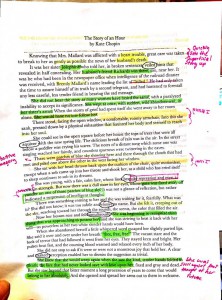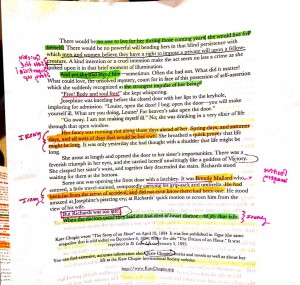While reading “The Story of an Hour” by Kate Chopin, a reoccurring literary technique I kept coming across was irony. First, the story sets up with the knowledge that Mrs. Mallard has heart problems and is about to find out that her husband has died. Readers might suspect that combined with her heart troubles, the news of her husbands death would upset her so much, she would die too. Ironically enough, the story goes on to describe her joy with the revelation of her new found freedom. Another pattern that can be seen in this writing is imagery. For example, when Mrs. Mallard is gazing out of the window at the patches of blue sky or the spring trees, there is a sense of looking toward the future or new beginnings. After which she first expresses verbally that she is free. Ms. Mallard admits her love for him, but that now she could “live for herself”, she even prays that her life will be long. Imagery can be shown to reflect her emotions here as well, and she thinks the spring and summer days that will now belong to her.
Again irony strikes, and suddenly through the front door her husband Brently Mallard enters with absolutely no knowledge of the railroad accident. Imagery here depicts Mr. Mallards appearance as “a little travel-stained, composedly carrying his grip-sack and umbrella” (which explains that physically he is healthy – and not dead). Mr. Mallard was surprised at Mrs. Mallards reaction to him, and in the final act of an ironic twist, Mrs. Mallard dies. When the doctors arrive, the story states that “she had died of heart disease – of the joy that kills” which leaves open to the reader to interpret that it was assumed she was so overjoyed to see her husband alive; it killed her. A theme of this writing is tragedy, since it seems inevitable that Mrs. Mallard would die of her heart disease throughout the reading.





